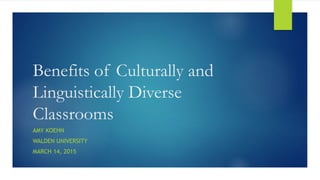
Benefits of culturally and linguistically diverse classrooms
- 1. Benefits of Culturally and Linguistically Diverse Classrooms AMY KOEHN WALDEN UNIVERSITY MARCH 14, 2015
- 2. The Value of Diversity “All students bring cultural values and experiences to their education, yet schools frequently disregard them, particularly teachers who are unfamiliar with their students’ cultures. …It makes sense for teachers to learn about the students in their classrooms as well as about their families, prior experiences, cultural practices and values,” (Hawley & Nieto, 2010, p. 69).
- 3. “Sebastian” (not his real name) Male 8 years old Second grader Youngest of three siblings
- 4. Background Information Home Language Parents are native Spanish speakers. Mother speaks very little English. Father speaks some English, but is very limited. Older siblings are bilingual in Spanish and English Sebastian speaks nearly proficient English and also speaks fluent Spanish. Socioeconomic Status Parents are migrant workers Family has traveled to Texas, Florida, Arizona, California and now Michigan Live in a small sub-community of migrant families on the east side of town Children all qualify for free/reduced lunch
- 5. Academic Challenges Written communication is significantly affected by language and mobility Gaps in learning due to family mobility throughout the school year Vocabulary development and oral reading fluency are significantly behind grade level benchmarks Cultural differences with majority of the class (beliefs, traditions, experiences, etc.) Lack of connection to peers
- 6. Funds of Knowledge “Teachers who truly embrace culturally responsive pedagogy recognize the importance of helping EL students make meaningful connections between their existing schema and content area concepts and skills,” (Brooks & Karathanos, 2009, p.47).
- 7. Funds of Knowledge Linguistic Fluency in Spanish Orally near proficiency in English Basic sound-letter correspondence understanding in English Cultural Understanding and experience of Hispanic traditions and beliefs Diversity of food experiences Music, sports and video game diversity
- 8. Funds of Knowledge Family Bilingual Sibling support for school, academics and social behaviors Strong work ethic Agricultural experience that relates directly to our community Experiences Extensive travel in the United States Holiday and Cultural celebrations Experience with harvesting fruits and vegetables Multiple school experiences
- 9. Funds of Knowledge Practical Could provide translation help with instructional materials that include Spanish words, phrases or references Could help students during plant unit providing personal experience with harvesting local crops Peer support for new students and other migrant children and families
- 10. Literacy Expectations of the Common Core State Standards “[the] goal is to provide all English- language learners, regardless of their language proficiency levels, the same opportunities to demonstrate their content knowledge and skills as their peers who are native English-speakers or former English-learners,” (Maxwell, 2013a, p. 1).
- 11. Schools are Recommended by the CCSS to Provide: Appropriate instructional supports to make grade-level course work comprehensible Modified assessments that allow ELLs to demonstrate their content knowledge Additional time for ELLs to complete tasks and assessments Opportunities for classroom interactions (both listening and speaking) that develop concepts and academic language in the disciplines Opportunities for ELLs to interact with proficient English speakers Opportunities for ELLs to build on their strengths, prior experiences, and background knowledge Qualified teachers who use practices found to be effective in improving student achievement (Common Core State Standards Initiative, n.d.)
- 12. Strengths of the Standards for Language Learners: Prepares all students, including ELLs for college and careers and to participate fully in what has become a global workplace (Language Magazine, 2015). Encourages significant collaboration between content area teachers and teachers of ELL students, which my increase scaffolds and support for ELLs in the general classroom and content area instruction.
- 13. Challenges of the Standards for Language Learners: Making CCSS content accessible to ELLs who are deficient in oral and written communication skills, (Coleman & Goldenberg, 2012). Schools need to establish a school-wide focus on literacy, (Language Magazine, 2015). Extra scaffolding needs to be in place to support ELLs for vocabulary as well as oral and reading fluency in English Text complexity and the focus of the standards on the learner creating meaning, puts additional burdens on ELL students who could previously rely on the teacher to help with vocabulary and meaning construction.
- 14. Overcoming these Challenges Maxwell suggests teachers spend time, “…picking apart the standards, stripping them down to the essential concepts, simplifying the language and developing strategies that all of them can use to support English-learners in both content and ESL classes,” (2013b, p. S9).
- 15. Instructional Strategies to Help Overcome Challenges for ELLs and the Standards: Collaboration between ESL and content-area teachers Including language and content instruction throughout the academic day Utilizing “push-in” support to provide additional scaffolding for ELLs Helping teachers develop a deep understanding of language acquisition Time devoted to getting to know individual students and their specific learning needs Identifying and addressing cultural and linguistic differences that may enhance or hinder learning Explicitly teach academic language related to content (Maxwell, 2013b)
- 16. References: Brooks, K., & Karathanos, K. (2009). Building on the cultural and linguistic capital of English learner (EL) students. Multicultural Education, 16(4), 47–51. Coleman, R. and Goldenberg, C. (2012). The common core challenge for English language learners. Principal Leadership, 12, 46-51. Common Core State Standards Initiative. (n.d.). About the standards. Retrieved from http://www.corestandards.org/ Hawley, W. D., & Nieto, S. (2010). Another inconvenient truth: Race and ethnicity matter. Educational Leadership, 68(3), 66–71. Language Magazine. (2015) Cutting to the common core. Retrieved from http://languagemagazine.com/?page_id=4130. Maxwell, L. A. (2013a). Consortia struggle with ELL provisions. Education Week, 32(27), 1–17. Maxwell, L. A. (2013b). Standards and English-learners: It takes a village. Education Week, 33(10), S9–S12.